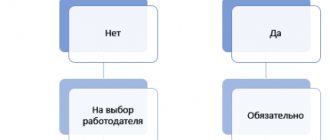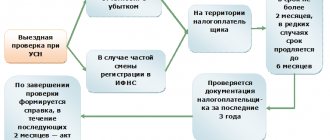Types of statute of limitations for paying taxes
Payment of accrued taxes and fees is the direct responsibility of the taxpayer . The Tax Code of the Russian Federation clearly regulates the procedure for determining the amount of tax and the timing of its payment.
By missing these deadlines, failing to pay the tax or paying it in full, the taxpayer commits a tax offense . Accordingly, the tax authorities have every right to recover this amount within the framework of current legislation. However, there are certain time limits.
The civil law establishes a statute of limitations - this is the period (maximum 3 years) during which a violation of the right can be challenged in a claim. However, civil legislation regarding the limitation period does not apply to tax relations - the Tax Code is more important here.
The Tax Code of the Russian Federation establishes 2 types of limitation periods for taxpayers:
- the statute of limitations for bringing to justice for committing a tax offense means that if the offense occurred more than 3 years ago, then it is no longer possible to be held accountable for it;
- statute of limitations - means that the tax office can sue to collect the debt within 6 months or 2 years (subject to certain conditions, which will be discussed later) after notifying the debtor.
Therefore, it is important to understand the difference between the statute of limitations and the statute of limitations for liability.
These 2 periods are counted independently of each other. For example, if the trial lasts more than 3 years, the case will be closed - the court simply will not be able to make a decision on collection. At the same time, the obligation to pay tax does not disappear even after 3 years - the debt continues to be registered with the taxpayer, but it will not be possible to collect it.
The debt can be completely written off, for example, if the court decides that it is impossible to collect it. Then the debt is considered uncollectible, after which it is written off in accordance with the Tax Code.
It is worth noting that the period of 3 years applies not only to debts on taxes, fines and penalties. This period applies to liability for various tax offenses, including:
- violations of registration rules;
- failure to report;
- filing a declaration in a manner inconsistent with the law;
- violations of tax accounting rules, etc.
The statute of limitations of 6 months or 2 years relates directly to the collection of tax arrears.
Methods for collecting arrears by the tax authority
First, the tax authority generates a demand for tax payment. In it, he indicates the amount of tax not paid on time and the period within which it must be repaid. This is stated in paragraph 1 of Article 69 of the Tax Code of the Russian Federation. If this requirement is ignored by an organization or individual entrepreneur, the tax authority will take all measures (within the law) to obtain this amount of money. There are two ways:
- collection without going to court (indisputable collection);
- recovery by going to court.
Collection without going to court, that is, out of court, occurs upon a demand for tax payment if an organization or individual entrepreneur does not pay the amount specified in the demand within two months. In this case:
- The tax authority will make a decision to collect the required amount of tax from the accounts belonging to the organization or individual entrepreneur. This decision is either handed to the representative against receipt or sent by mail;
- after this, the tax authority will send an order to the bank of the organization or individual entrepreneur to write off the required amount to the budget. Based on this instruction, the bank will write off the required amount no later than one day following the day of receipt of this instruction.
If there is no money in the account or not enough, then the tax authorities can compensate for the arrears at the expense of the property of the organization or individual entrepreneur. To do this, the tax authority may decide to collect taxes from the property. This decision can be made within a year from the date of expiration of the tax payment deadline. The tax authority sends this decision to the bailiffs, who either seize the property or can forcibly sell it as part of enforcement proceedings.
Collection by going to court looks a little different:
- if the deadline for the requirement to pay the tax has expired and the deadline for collection from the funds of the organization or individual entrepreneur has been missed, then within 6 months;
- if the deadline for the requirement to pay the tax has expired and the deadline for collection at the expense of the property of the organization or individual entrepreneur has been missed, then within 2 years.
In some cases, the arrears may be written off as an uncollectible amount. This is possible in some cases, for example, if an organization is liquidated and there is not enough money in the form of the organization’s property or the property of the founders. Or another case is when an individual entrepreneur dies, and the value of the inheritance is less than the tax debt.
How is the statute of limitations for tax liability calculated?
As mentioned above, Article 113 of the Tax Code of the Russian Federation establishes that after 3 years after the commission of a tax offense, the payer can no longer be held accountable for this.
However, determining the point from which these 3 years are counted is not so easy. The Tax Code of the Russian Federation requires counting 3 years from this moment:
- in case of violation of the rules for accounting for income and expenses (that is, when the object of taxation is understated) or non-payment (incomplete payment) of tax - from the first day following the end of the tax period in which the offense occurred;
- in all other cases - from the day the law was violated.
In simple terms, if tax is not paid, 3 years are counted starting from the next tax period.
Let's look at this using specific taxes as an example. For taxes paid by individuals (not individual entrepreneurs) - land, transport, property and income tax, which a person pays independently - the period is a year.
According to legal requirements, these taxes must be paid by December 1 of the following year. Accordingly, the timing will be calculated as follows:
- 2018 – tax period;
- You must pay tax for 2021 by December 1, 2021;
- If there is no payment on December 1, 2021 (more precisely, December 2, since the 1st day falls on a day off), a tax violation arises. 3 years begin to count down;
- 2020 is the first year;
- 2021 – second year;
- 2022 – third year;
- from January 1, 2023 – the debtor can no longer be held accountable for failure to pay taxes for 2021.
As you can see, the payer cannot be punished for non-payment of tax for 2021 only starting from January 1, 2023. But this applies only to the amount for 2021, and if the tax is not paid for 2021, a separate period is calculated for it.
However, as stated above, the obligation to pay is not removed from the debtor. The debt will be registered with him up to such moments as:
- payment of the amount owed;
- liquidation of a legal entity or bankruptcy of an individual;
- death of an individual;
- adoption by the court of a decision by which the tax authority loses the ability to collect the debt (that is, recognizing the debt as bad).
However, the tax office can only collect a debt for 3 years, which in some cases seriously reduces the amount of tax service requirements (for example, when they calculate the tax for an apartment for 5-10 years, they can only demand payment of the tax for 3 years).
It is important that if the tax service or the court made a decision to hold the debtor accountable, and at the time of making this decision 3 years have not passed, then the decision will have to be executed. It is believed that the very fact of making a decision to prosecute interrupts the 3-year period.
When the inspection makes a requirement
So, if a tax arrears are discovered, the inspectorate must issue a demand to the debtor to pay taxes, penalties, fines, and interest.
If the arrears are identified during a tax audit, then the demand must be made no later than 20 working days from the moment when the decision made based on the results of the audit came into force (clause 6 of Article 6.1, subclauses 2, 3 of Article 70, clause 1, Article 87, subparagraphs 7, 9, Article 101 of the Tax Code of the Russian Federation).
If the arrears are identified outside the scope of the taxpayer’s audits, then the deadline for sending the claim depends on the amount of the debt (subclauses 1, 3 of Article 70, clause 10 of Article 101.4 of the Tax Code of the Russian Federation).
If the debt is 500 rubles or more, the demand must be sent to the taxpayer within 3 months from the date of discovery of the arrears. If the debt is less than 500 rubles - within 1 year from the date of its discovery.
How is the statute of limitations for taxes calculated?
The statute of limitations for taxes is needed so that tax officials can notify the payer about the existence of a debt, and if he does not respond, file a lawsuit.
First of all, it is worth considering that the tax office can collect a debt from organizations or individual entrepreneurs without even going to court - in an indisputable manner. It is believed that if the Federal Tax Service has accrued a debt, then the entrepreneur must pay it without any questions.
In this case, after refusing to pay taxes on demand, the tax office issues a decision to collect the debt, then sends a payment request to the bank where the debtor’s accounts are opened. If there is a sufficient amount in the debtor’s accounts, then her bank is obliged to transfer it to the specified account of the budget system.
Debt can only be collected from ordinary citizens (who are not individual entrepreneurs) in court. To do this, the INFS must first of all issue a demand for payment of tax to the debtor.
However, the overall process is complex and involves several steps:
- First, the tax office “discovers” the arrears. This happens automatically the next day after the deadline for payment expires (of course, if the tax has not been paid);
- then the Federal Tax Service makes a demand for tax payment. It is issued within 3 months after the debt is discovered (for debts less than 500 rubles, this period is 1 year).
There are several features associated with the additional assessment of taxes based on the results of an audit, but this applies more to organizations. The request for payment indicates the amount of the debt, an explanation of its origin, details for payment and the deadline for payment (if the deadline is not specified, it is equal to 8 working days). - if within 2 months after the demand was sent to the debtor, he did not pay the debt, then a decision on collection is made. The Federal Tax Service can file a lawsuit within 6 months after the date specified in the request. Taking into account the 2 months of waiting, 4 months remain.
The period of 6 months applies to cases when the Federal Tax Service collects funds in the amount of more than 3,000 rubles. If the object of foreclosure is other property, the period will be up to 2 years.
And if the amount of debt is less than 3,000 rubles, the tax office will “wait” until the amount exceeds this value, but no more than 3 years . If after 3 years the debt is less than 3 thousand, they will go to court to recover the accumulated amount. But taking into account the statute of limitations for prosecution (3 years), it will be virtually impossible to collect the debt.
Thus, after receiving a tax payment request from the INFS, it must usually be fulfilled within 8 working days. Otherwise, after 2 months you should wait for a summons to court.
What day is considered the day of detection of tax arrears if no audit was carried out?
As is known, a requirement to pay debts that were not identified as part of an audit can be made no later than 3 months from the date the arrears were identified Tax Code Article 70. However, nowhere in the Tax Code of the Russian Federation does it say what the date of discovery of the arrears is.
Content
When arrears arise
Let us recall that arrears are the amount of tax not paid within the time limit established by the Tax Code. Tax Code Article 11. From this definition it follows that it can arise only when the amount of tax is accrued, but is not paid to the budget on time.
The tax authority must be informed that the tax has not been paid the next day after the payment deadline. And he learns about the amount of accrued tax from the tax return.
This means that arrears can only be detected after you:
- submitted a declaration with the amount of tax payable,
- missed the tax payment deadline.
Let us illustrate what has been said. The last day for paying UTII for the first quarter is April 25. Tax Code Article 346.32, the tax is not paid on time.
OPTION 1. The taxpayer submitted a UTII return for the first quarter on April 20 Tax Code Article 346.32 or earlier. Until April 25, you don’t have to pay the tax and there will be no arrears. We can talk about its availability only from April 26th. From the same day, the 3-month period for submitting a claim will begin to count. Thus, the last day of its display will be July 26th.
OPTION 2. The UTII declaration for the first quarter was submitted in violation of the deadline - April 24 Tax Code Article 346.32. In this case, the deadline for submitting a claim will run the same as in option 1.
OPTION 3. The UTII declaration for the first quarter was submitted in violation of the deadline - April 30 Tax Code Article 346.32. Before submitting the declaration, the tax office cannot make a demand, since it will not know the amount of the arrears.
Therefore, the deadline for submitting a claim under this declaration will begin on May 1 and its last day will be July 31.
Inspectors have their own approach
However, in practice, tax authorities often count the deadline for issuing a claim not from the date specified by us, but from any moment of discovery of arrears in their internal documents and databases. And this approach sometimes finds support.
Note. If arrears are identified outside the scope of a tax audit, the tax inspectorate draws up a document identifying the arrears from the taxpayer (payer of fees) or tax agent. From the date of drawing up this document, it begins to count down the period for issuing a claim.
However, the prevailing opinion in judicial practice is that the discovery by the tax authority of data in its internal documents cannot indicate either the presence of arrears or the presence of overpayments, since such data completely depend on the actions of its employees. And the courts refuse to collect arrears on claims submitted in violation of deadlines. For example, in one of the court decisions the following situation was considered. The inspectorate made a mistake when reflecting tax accruals on the entrepreneur's personal account card. Having corrected it after 2 years, she made a demand for additional tax payment within 3 months from the moment she discovered her error and made corrections to the card. But the court refused to collect this arrears, arguing it as follows. The tax arrears arose not as a result of unlawful (guilty) actions of the entrepreneur, but because of an inspection error. And the inspection had the opportunity to timely identify arrears and send demands to the entrepreneur
Yes, but she did it only 2 years later. This means that she lost the right to collect the disputed amount of tax.
***
I would like to wish you not to forget about the deadlines for paying taxes. And if you receive a demand for payment of arrears that were not revealed as a result of an audit, treat it carefully: check both the basis and the timing of its submission. If there are violations, the claim can be challenged either in a higher tax authority or in court.
First published in the magazine "Glavnaya Kniga" 2010, N 5
Kononenko A.
Legal documents
- (Tax Code Article 11)
- (Tax Code Article 346.32)
- (Tax Code Article 346.32)
- (Tax Code Article 346.32)
- (Tax Code Article 346.32)
When is it possible to write off tax arrears?
If the statute of limitations for debt to the budget has expired, then the tax authorities will not be able to oblige the debtor to pay the arrears, despite the fact that the debt will still be registered with him. However, if such a debt is deemed uncollectible, it may be excluded from the card for settlements with the budget.
According to sub. 1-4.1 clause 1 art. 59 of the Tax Code of the Russian Federation, a debt is recognized as uncollectible in the following cases:
- upon liquidation of the company;
- when an individual entrepreneur is declared bankrupt;
- in the event of the death of an individual, if he was a debtor for taxes and fees;
- if there is a court decision, according to which the tax authorities do not have the right to demand payment of arrears of taxes, penalties, etc. from the debtor;
- when a bailiff makes a decision to complete proceedings on an executive document with the return of such a document to the claimant (clauses 3, 4, part 1, article 46 of the federal law of October 2, 2007 No. 229-FZ “On Enforcement Proceedings”), provided that a this debt is more than 5 years ago, in the following cases:
- the amount of debt is equal to or lower than the amount of claims against the debtor established by the legislation of the Russian Federation on insolvency (bankruptcy) for initiating bankruptcy proceedings;
- the court returns the application for declaring the debtor bankrupt or terminates the bankruptcy proceedings due to the lack of funds necessary to compensate for legal costs for the procedures applied in the bankruptcy case.
If there is no money
If it is not possible to collect the debt at the expense of the debtor’s funds (there are none or not enough to pay off the debt), then the inspectorate, no later than 1 year after the end of the deadline for fulfilling the requirement to pay the debt, makes a decision on its collection at the expense of the taxpayer’s property (clause 7, article 46 , clause 1 of article 47 of the Tax Code of the Russian Federation). Collection of arrears, penalties and other tax debts at the expense of property is carried out in the manner prescribed by Article 47 of the Tax Code of the Russian Federation. The inspectorate issues a special resolution in the form approved by order of the Federal Tax Service of Russia on February 13, 2021 No. ММВ-7-8/ [email protected] and transmits it to the bailiff service.
The decision to collect arrears and fines from the company’s property can be made within a year after the deadline for fulfilling the requirement for their payment. Otherwise, the decision is invalid (clause 1 of Article 47 of the Tax Code of the Russian Federation).
And one more thing you need to remember is this. Despite the fact that the statute of limitations for tax offenses is three years, this is not a basis for writing off tax debt, and does not mean that the inspectorate cannot collect it.








